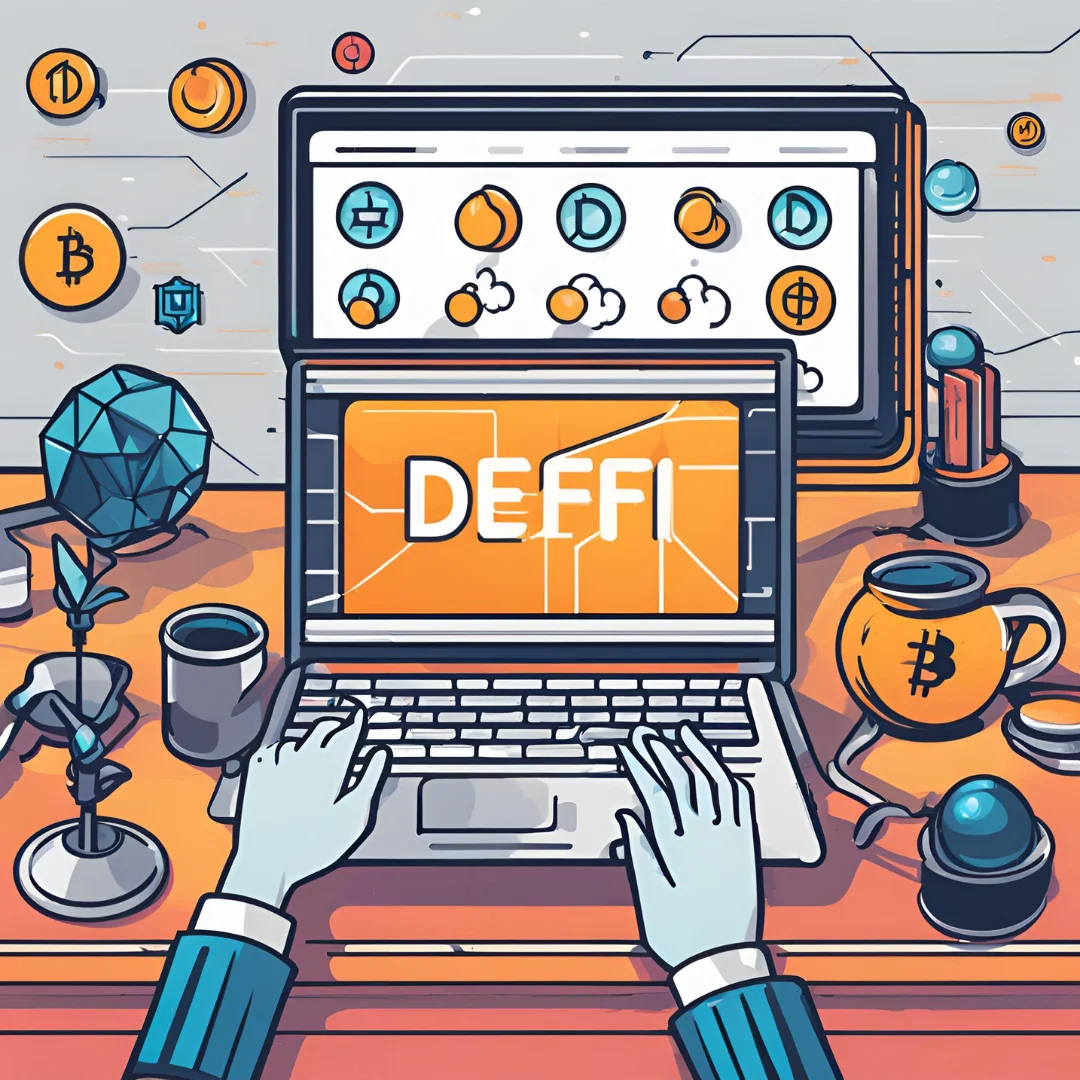The method by which people generate passive income from cryptocurrencies has been revolutionized by Decentralized Finance (DeFi). By lending, staking, and providing liquidity, DeFi platforms enable users to generate far larger returns than traditional banks, which offer negligible interest rates. However, it might be difficult to choose the ideal platform for earning interest on your cryptocurrency given the hundreds of DeFi protocols accessible.
This guide will explain the most important things to look for when selecting a DeFi platform, the top choices currently on the market, and how to optimize profits while lowering risks.
Understanding DeFi and How It Works
What is DeFi?
A group of blockchain-based financial services known as DeFi function without the use of middlemen like banks or brokers. Through smart contracts—self-executing agreements with predetermined rules—it allows users to lend, borrow, trade, and earn interest on their cryptocurrency holdings.
How Do DeFi Interest-Earning Platforms Work?
Users can deposit their cryptocurrency holdings into staking mechanisms, liquidity pools, or lending protocols through DeFi platforms. They receive interest in exchange in the form of yield farming incentives, governance awards, or more tokens.
The primary ways to earn interest in DeFi include:
-
Lending and Borrowing – Users can earn money by lending their cryptocurrency to borrowers.
-
Staking – To validate transactions and gain rewards, cryptocurrency is locked in a network.
-
Liquidity Mining/Yield Farming – supplying decentralized exchanges (DEXs) with liquidity in return for token incentives and fees.
Now that we understand the basics, let’s explore how to choose the best DeFi platform.
Key Factors to Consider When Choosing a DeFi Platform
1. Security and Audits
The most crucial consideration when selecting a DeFi platform is security. Smart contract vulnerabilities have led to the exploitation of numerous protocols.
✅ Look for platforms that:
-
have had third-party security audits conducted by companies such as Quantstamp, Trail of Bits, or CertiK.
-
possess a solid record free of significant hacks.
-
Provide bug bounty schemes to encourage security enhancements.
🚨 Avoid platforms with:
-
developers that are anonymous and without a track record.
-
No openness regarding security measures or security audits.
2. Interest Rates and Returns (APY)
There are differences in the Annual Percentage Yield (APY) between DeFi platforms. Better returns are associated with higher APY, but there may be more risk involved.
✅ Compare:
-
Fixed APY vs. Variable APY – While the returns on some platforms are consistent, those on others vary according to supply and demand.
-
Stablecoins vs. Crypto Assets – While volatile assets like ETH or BTC may produce larger but riskier returns, stablecoins (USDT, USDC, and DAI) often offer safer returns.
🚨 Be cautious of platforms offering extremely high APYs (over 1000%), as they may be unsustainable.
3. Supported Cryptocurrencies
Certain DeFi platforms only accept particular tokens. Make sure the platform you use accepts the cryptocurrency of your choice.
✅ Best platforms support:
-
Stablecoins (USDT, USDC, DAI) for safer interest earnings.
-
Popular cryptos (ETH, BTC, BNB, SOL) for higher-yield opportunities.
🚨 Be cautious of platforms that focus only on low-market-cap tokens with limited liquidity.
4. Platform Reputation and Community Trust
A reputable DeFi platform will have:
-
For developers with experience in the cryptocurrency space.
-
a robust online community (active on Twitter, Discord, and Telegram).
-
positive comments posted by actual users on websites such as Trustpilot and Reddit.
🚨 If a platform has frequent withdrawal issues, lacks transparency, or has many negative reviews, it’s best to avoid it.
5. Liquidity and Total Value Locked (TVL)
The total amount of assets deposited on a DeFi platform is measured as Total Value Locked (TVL). In general, higher TVL means:
-
Greater liquidity.
-
Increased platform stability.
✅ Check TVL rankings on DeFiLlama or DappRadar to find the most liquid and reliable platforms.
🚨 Low liquidity can lead to higher slippage and difficulty withdrawing funds.
6. Fees and Withdrawal Limits
Different DeFi platforms have varying fees for deposits, withdrawals, and transactions.
✅ Choose platforms with:
-
Low or transparent fees.
-
No hidden withdrawal limits.
🚨 Watch out for platforms that charge excessive fees or delay withdrawals.
7. Insurance and Risk Mitigation
To guard against smart contract malfunctions or hackers, several DeFi platforms provide insurance solutions.
✅ Check for:
-
Protocol insurance services, such as InsurAce or Nexus Mutual.
-
platforms that provide money to users who have been hacked.
🚨 Avoid platforms with no clear risk management strategy.
Best DeFi Platforms for Earning Interest on Crypto
1. Aave (AAVE) – Best for Crypto Lending
-
APY: 2%–15% (varies by asset).
-
Supported Assets: ETH, USDT, USDC, DAI, and more.
-
Security: Highly audited and trusted.
✅ Why Choose Aave?
-
No lock-up period – withdraw anytime.
-
Allows borrowing against deposits.
-
Supports stable and variable interest rates.
🚨 Potential Risks:
-
Variable APY can change rapidly.
2. Compound (COMP) – Best for Automated Interest Earnings
-
APY: 1.5%–10%.
-
Supported Assets: ETH, USDC, DAI, COMP.
-
Security: Highly secure, widely used.
✅ Why Choose Compound?
-
Algorithmic interest adjustments maximize returns.
-
Decentralized governance with COMP tokens.
🚨 Potential Risks:
-
Liquidation risks if borrowing against deposits.
3. Curve Finance (CRV) – Best for Stablecoin Yield Farming
-
APY: 5%–50% for stablecoins.
-
Supported Assets: USDT, USDC, DAI, FRAX, etc.
-
Security: Audited but has had minor past exploits.
✅ Why Choose Curve?
-
Focuses on low-slippage stablecoin trading.
-
Great for stable, high-yield investments.
🚨 Potential Risks:
-
Smart contract risks and occasional impermanent loss.
4. Yearn Finance (YFI) – Best for Automated Yield Optimization
-
APY: Varies based on vault strategy (5%–80%).
-
Supported Assets: ETH, BTC, stablecoins.
-
Security: Regular audits but relies on third-party protocols.
✅ Why Choose Yearn?
-
Automates yield farming strategies for better returns.
-
Saves time and optimizes earnings.
🚨 Potential Risks:
-
Dependent on other protocols like Aave and Curve.
5. PancakeSwap (CAKE) – Best for Binance Smart Chain (BSC) Yield Farming
-
APY: 20%–200% on liquidity pools.
-
Supported Assets: BNB, BUSD, CAKE, USDT, and many more.
-
Security: Audited but still carries risks.
✅ Why Choose PancakeSwap?
-
Low fees on Binance Smart Chain.
-
High-yield opportunities in farms and pools.
🚨 Potential Risks:
-
Impermanent loss in liquidity pools.
Final Tips for Maximizing Your Earnings on DeFi Platforms
-
Diversify your investments across multiple platforms to reduce risk.
-
Reinvest earnings (compound interest) for greater returns.
-
Use hardware wallets like Ledger or Trezor for added security.
-
Keep track of APY changes – rates can fluctuate rapidly.
-
Stay updated on DeFi news to avoid scams or rug pulls.
Conclusion
A thorough assessment of security, APY, liquidity, fees, and platform reputation is necessary when selecting the finest DeFi platform for cryptocurrency interest income. Always conduct your own research before making an investment, even though Aave, Compound, Curve, Yearn Finance, and PancakeSwap provide some of the greatest prospects.
In the rapidly changing world of DeFi, you may optimize passive income while lowering risks by diversifying your investments and adhering to security best practices. 🚀




